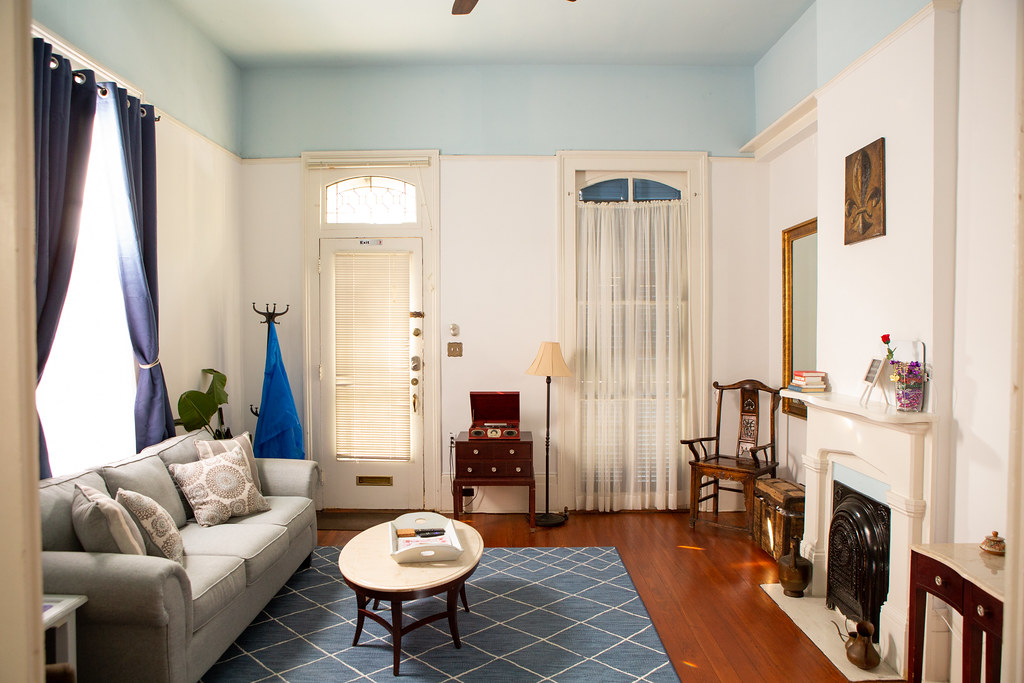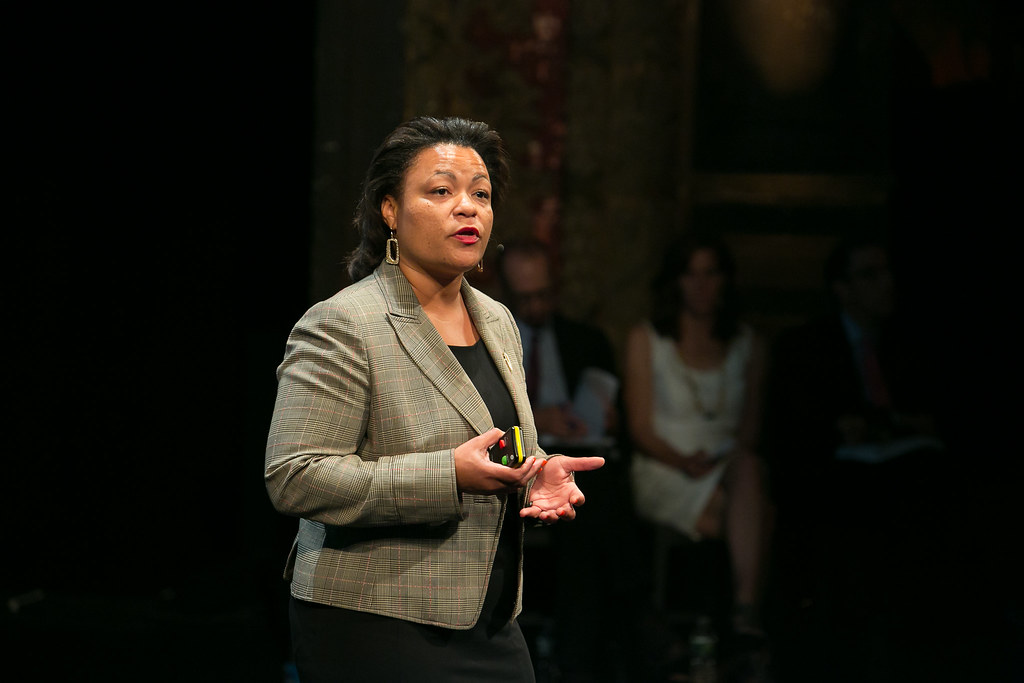
The inside of an Airbnb property in New Orleans (Photo By: _reel_, Flickr)
Part I: The Problem
New Orleans has a vampire problem. The streets of New Orleans are increasingly populated, not with the bloodsuckers of local legend Anne Rice, but rather with hundreds of short-term rentals, most notably Airbnb properties, that are sucking the life out of residents who cannot find affordable housing solutions. New Orleans’ local government has fought hard for the taxation of Airbnb, but the practice of converting traditional, less profitable rental properties into short-term rentals has nevertheless led to gentrification and an affordable housing crisis throughout the city.
The affordable housing crisis, at its root, is simple to understand, but growing in severity. Housing is necessary for success in America, and low-income individuals can not afford housing. In addition, there is a compounding effect when families lacking affordable housing “have constrained opportunities to increase earnings,” further limiting their ability to afford housing.
In America, there is currently a housing shortage of 7 million affordable homes for families on the poverty line. Additionally, 57% of lower-income families report that affordable housing is a major issue in their area. This number rises to a whopping 66% for low-income families in urban areas like New Orleans.
Research conducted in Los Angeles shows that Airbnb reduces the affordable housing supply through two key mechanisms: conversion, in which an affordable housing option is removed from the rental market, driving up rents throughout the city, and “hotelization” in which it is cheaper to maintain an Airbnb than a hotel room and owners still receive the significant “short term rental premium” over long-term renting for residents.
The price effect of supply shock due to Airbnb “conversions” for each 1% decrease in housing supply is a 0.2% increase in rent costs. In practice, for LA neighborhoods with the highest concentration of Airbnb properties, rent is 20% higher than adjacent areas and increases 33% faster compared to the city average.
Airbnb claims that it is primarily for middle-class individuals to supplement their income by letting out extra rooms, but research has shown that 89% of revenue comes from properties without on-site hosts, a statistic that flies in the face of Airbnb’s prevailing narrative. In 2014, Airbnb properties eliminated 1% of rental properties, and city-wide rent increased by 7.4%, an indication that Airbnb has contributed more to citywide evictions and supply decrease than any supplementary income for middle-class individuals.
For individuals impacted by the affordable housing crisis, as determined by residual income after housing costs, 37.7% were considered “deprived” of necessities related to physical and mental well-being. Additionally, health-related quality of life, as measured by Physical Component and Mental Component Testing, shows lower mean quality of life as housing affordability decreases incrementally.
Housing quality also has a significant impact on the mental health of children. One study, following rural children in poor housing conditions, shows that 15 years later, these children express poor psychological health, particularly feelings of “helplessness”. These psychological effects reduce career earnings by one-quarter throughout the course of the child’s life, perpetuating the cycle of poverty.
Airbnb and the affordable housing crisis have been shown to contribute to “gentrification” in many communities in a statistically significant manner. Gentrification is described as a phenomenon in which traditionally low-income areas quickly experience rising housing costs that push longtime residents out of the area. Gentrification often significantly impacts communities of color, with studies showing that increasing gentrification and an influx of wealthy white developers leads to a significantly decreasing chance (66% to 29%) of electing a black city council member to represent an area that had been historically black.
In New Orleans specifically, the affordable housing crisis is particularly dire for several reasons. New Orleans ranks 2nd in the nation for the percentage of renters paying half of their income for housing, with 38% of New Orleanians being cost-burdened in this manner. 80% of those affected by the affordable housing crisis in New Orleans are black residents.
Jane Place, a local organization dedicated to providing affordable housing solutions in New Orleans, estimates that 33,000 affordable housing units are needed to counteract rising rent prices and Airbnb conversion. Meanwhile, at the end of a 5-year commitment to provide 7,500 affordable housing units by the end of 2020, the New Orleans government had struggled to construct only 1,557 units.
Lack of supply is not the only issue. A unique reliance on tourism has also driven the affordable housing crisis in New Orleans. The number of Airbnb properties in the city spiked from 1,905 to 6,508 in only three years from 2015-2018, as wealthy (predominantly white) investors swooped in to capitalize on the tourism hotspot by snatching up properties for short-term rentals in neighborhoods like Treme, Bywater, Marigny, and other neighborhoods around the French Quarter. The tourism economy magnifies the affordable housing crisis further as low-income individuals work in a low-paying, temperamental industry where pay has increased by only 2% in the last two decades while rent soars up 50% in the same period of time.
Part II: Data-Driven Solution
One solution to affordable housing that appears extremely foreign to an American, both geographically and politically, is Berlin’s overwhelming concentration of rental properties in the hands of the state.
In Berlin, where 85% of the city’s residents rent, affordable housing developed into a political flashpoint as rent prices more than doubled between 2009 and 2019. Following a five-year rent freeze that was declared unconstitutional, a new referendum on rent reform was passed, with a key part of that reform being an emphasis on state acquisition and management of affordable housing.

Katrin Lompscher, Berlin Senator for Urban Development and Housing (Photo By: Sandra Brunner, Flickr)
According to Katrin Lompscher, Senator for Urban Development and Housing, “The Senate of Berlin wants to organize the growth of the city in a socially acceptable way, making sure that Berlin continues to be a city that is worth living in for all people,” but unlike the statements of city governments in the United States, these statements were accompanied by radical action.
Berlin’s government has rapidly purchased rental properties in the city and now owns 17% of the total number of Berlin rental properties. In comparison, the highest percentage of state-owned housing in the US was only 5% in New York City. In the last 6 months alone, Germany purchased 14,750 apartments from private companies Vonovia and Deutsche Wohnen, representing 10% of their holdings.
Apart from increased government acquisition of privately-held apartments, the German government has a “right of first refusal law” that allows the government to purchase properties before they go on the market. This right was rarely exercised until one district of Berlin began rapidly purchasing properties using this right, which led to more widespread utilization of the law.
In 2017, six municipally-owned housing corporations came together to commit to expanding affordable housing options, seeking an expansion of 400,000 more flats throughout Berlin by 2026, while also purchasing commercially owned flats and increasing state control of affordable housing.
Along with this initiative, these six companies all agreed on several protection measures for their tenants. Firstly, that rent will not increase by more than 2% in any given year, a significant goal considering that flat rent has increased by 30.6% in the last five years. For low-income Berlin residents, in avoiding the rapid inflation of rent prices, they stand a greater chance of escaping the cycle of poverty.
Additionally, low-income individuals whose housing costs are 30% or more of their income are eligible to be reviewed for hardship and receive subsidies from the German National Bank to reduce the portion of their income going toward housing costs. Rental costs should not exceed more than 10% of a tenant’s yearly income in this system. In these ways, the German government addresses the affordable housing crisis both in terms of housing supply and housing costs.
For properties that require modernization efforts or extensive renovations, only a maximum of 6% of modernization costs can be passed on to tenants, preventing the government from foisting costs for new housing on the low-income tenants that this program is intended to help.
Additionally, in many other cities, including New Orleans, one issue is affordable housing being inefficiently used. For example, might find older retirees, living on a pension in three-bedroom flats. This effectively decreases the overall housing supply in a city, but it is often difficult for these tenants to leave their flats, or they may have little incentive to do so. Berlin’s six municipal companies facilitate the exchange of homes so that smaller families move out of larger flats.
Over the past ten years, studies have shown in Berlin, that the population staying in State-owned properties has lower unemployment rates and lower child poverty rates than the population staying in private company housing. In addition, this represents a victory for the German populace, who banded together to push this resolution through in a way that low-income tenants in the United States have been unable to do.
Some critiques of German policy are that the affordable housing supply could be more easily increased through the creation of new housing options. Unlike other cities like Singapore, which has taken similar measures with state-acquired affordable housing options, Germany has no shortage of available land with a population density that is half of Singapore’s and significantly below comparable European cities like Paris and London.
Strict zoning policies and housing covenants also contribute to an inability to create new affordable housing options that efficiently utilize Berlin’s airspace with highrise buildings. Noise ordinances make it difficult for the German government to construct new affordable housing properties.
Finally, concerns have arisen that the referendum has no legal power to drive the German government to meet its stated goals. The up-front costs of acquiring privately-owned rental properties are estimated at upwards of 40 billion euros, which would be untenable for the German government, leaving many pundits skeptical about the program.

LaToya Cantrell, New Orleans’ Mayor who has expressed concern about affordable housing, but faces mounting pressure to take action (Photo By: PopTech, Flickr)
Part III: Implementation In New Orleans
Berlin provides an intriguing example for New Orleans to follow in addressing their issues with affordable housing. That said, Berlin has a much smaller percentage of total Airbnb properties, with only around 25,197 properties in a city with over three million residents. In New Orleans, the short-term rental market would have to be considered in any solution.
Few precedents exist for state-owned affordable housing in the domestic market, even in New York City, the US city with the most state-owned residential properties. That said, the first step in this process is for city officials to recognize that the affordable housing crisis is not being solved by constructing new rental properties and that market forces and private entities are not going to solve this issue. In fact, private entities like Airbnb have only exacerbated the issue. The New Orleans government must recognize that drastic, even potentially controversial, measures are necessary before they undertake a concentration of affordable housing under the city government. They must be prepared to enact any measures necessary to allow for this program to begin, most notably a “right of first refusal law”. This law is not seen in United States cities like Berlin but has some legal precedents in laws surrounding planned housing communities and policies of eminent domain that allow the government to seize private property for public use, provided that owners are properly compensated.
The second part of this program, following legislative implementation, which could take months or years if appealed, would be acquiring properties for affordable housing, preferably Airbnbs owned by outside investors. Projections show that 33,000 new properties are necessary to counteract the affordable housing crisis in New Orleans. This is no small sum, and to set a modest goal of purchasing 10,000 unused commercial properties and Airbnbs unoccupied by permanent residents over the course of 7 years would cost roughly 514 million dollars per year (based on the average home price in New Orleans).
For a city that only projects to bring in around $640 million in tax revenue in 2022, the upfront cost of this project would require additional measures to reduce the cost or find new sources of revenue. One way to reduce cost is to disincentivize outside Airbnb investment in the same way that Denver has done: by banning short-term rentals without primary residents, enacting a significant lodging tax (10.6%) which allows traditional hotels to compete and slash revenue, and finally forcing licensing compliance through a fee system.
All of these measures will ban Airbnbs funded by outside investors and will disincentivize STR properties as an easy, unregulated cash flow, thus decreasing the asking price for these properties and driving down costs to more tenable levels.
Additionally, the use of municipal revenue bonds (traditionally used to raise capital for projects like stadiums and utilities) and housing bonds could be used to generate the up-front capital necessary from sources outside of Louisiana, an approach seen by California’s CalCHA. By incentivizing the selling of Airbnbs through regulatory procedures and raising capital through the creative use of debt securities, the City of New Orleans can reach the capital requirements necessary to concentrate affordable housing in the hands of the State and insulate low-income families from rapid inflation and predatory rental markets.
 NOLAbeings Multimedia artist Claire Bangser created NOLAbeings as a portrait-based story project that marries...
NOLAbeings Multimedia artist Claire Bangser created NOLAbeings as a portrait-based story project that marries...  Voodoo in New Orleans: Reviving history: New Orleans fortune telling This article takes a deep dive into the history of Voodoo in New Orleans, its hybridization with Catholicism, and its present-day place in the city's culture. The author visits fortune-tellers in the French Quarter, using their guidance as a tool for introspection rather than a deterministic predictor of the future. Through her experiences in New Orleans, the author feels a mystical connection to both the past and the future.
Voodoo in New Orleans: Reviving history: New Orleans fortune telling This article takes a deep dive into the history of Voodoo in New Orleans, its hybridization with Catholicism, and its present-day place in the city's culture. The author visits fortune-tellers in the French Quarter, using their guidance as a tool for introspection rather than a deterministic predictor of the future. Through her experiences in New Orleans, the author feels a mystical connection to both the past and the future. 